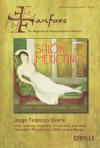Texte paru dans: / Appeared in: |
|
|
Reviewer: Bertil
van Boer
In 1710 Jan Dismas Zelenka
arrived in Dresden from Prague, where he had a career as a double bass
player and composer. His position at the Saxon court allowed him an
opportunity to maintain his connections with his former hometown, as well as
travel to Vienna to further his studies, and by 1720 he had already begun to
take on many of the required compositional duties for sacred works. One of
his first major commissions was a series of pieces for Holy Week, including
six Lamentations of the prophet Jeremiah and 27 responsories for the
offices, these generally being commentary on lessons usually delivered in
plainsong. The result was a cycle of works for Catholic Dresden that were
appropriate to the solemn season and reflected a longstanding tradition of
its princess, a Hapsburg, who was used to these elaborate types of pieces.
The responsories for hebdomada
sancta were performed at three times during the week: the Last Supper (coena
Domini), Paravesce, and Holy Saturday, all at Nocturns where at the close of
the day one could spend time to reflect both on the sermons themselves and
the musical responses. Leading off each set of these was a reading of the
Lamentations, a normally lengthy series of poems on the destruction of
Jerusalem by the Babylonians, each of which begins with a Hebrew letter
(Aleph, Bet, Gimmel, etc.). These texts always began with a melismatic
reading of the letter itself, a bit odd but certainly a solid tradition by
the early 18th century. Zelenka’s Holy Week music for this service very much
conforms to formula. The first set includes a very lengthy Lamentations,
though the second and third are much shorter, omitting large portions of the
text since they came later in the week. Of particular musical interest is
the march-like introduction of the first Lamentations, which seems to
present the entire set of services in distinctive hammer strokes. The
remaining Lamentations are much more conventional, with mild counterpoint,
very little ornamentation, and good textural contrast. The responsories are
all contrapuntal in strict style, although in the “Tristis est anima mea”
the slow choral introductions have some rather close harmonies in homophonic
style. Mostly, these are various types of strict fugues with various forms
of polyphony, almost like a compendium of early 18th-century counterpoint
one usually ascribes to Johann Sebastian Bach. There is a certain sameness
to the movements, all nicely interspersed by resonant plainsong ably
directed by tenor Hasan El-Dunia. Variety and word-painting are not part of
the compositional tools for this particular genre of composition, and the
subtleties of the intricate counterpoint do not require overt operatic
music, lyrical lines, or any sort of ornamentation at all, even though the
lines themselves are often melismatic. It is good to see the entire set of services, although it might be added that, as the bulk of the music from this period goes, it is static. This gives a good representation of how responsories and lessons are interwoven, with the Lamentations provided in place. The performance by Collegium 1704 is quite resonant, though this may be a factor of the recording venue in Prague. The trombones doubling the voices also provide an important sound, lending depth and power; the playing is equally subtle and nonintrusive as well as supportive. It is a sound that one would have found commonplace during the period and that is sometimes missing in recordings of sacred music from the Baroque. The voices do seem a bit muffled at times, but again, this is a recording issue, for the pitch is accurate and the often complex counterpoint is handled with ease. The Collegium Vocale provides the various pairs of voices in the responsories, reflecting the performance-practice note that Zelenka probably had no more than two on a part. Still, at times they sound much more full-bodied, especially in the antiphonal effects of the second responsory from Paravesce, “Velum temple scissum est.” In short, this is a fine disc and Zelenka fans will enjoy having it as a representation of his early, more conventional contrapuntal style in an accurate setting and order. As it is a series of solemn movements, caution might be exercised by those more used to a more florid and varied style, though perhaps there is a place for this excellent and thoughtful set in their collection. | |
|
|
|
|
|
|
|
Cliquez l'un ou l'autre
bouton pour découvrir bien d'autres critiques de CD |
|




